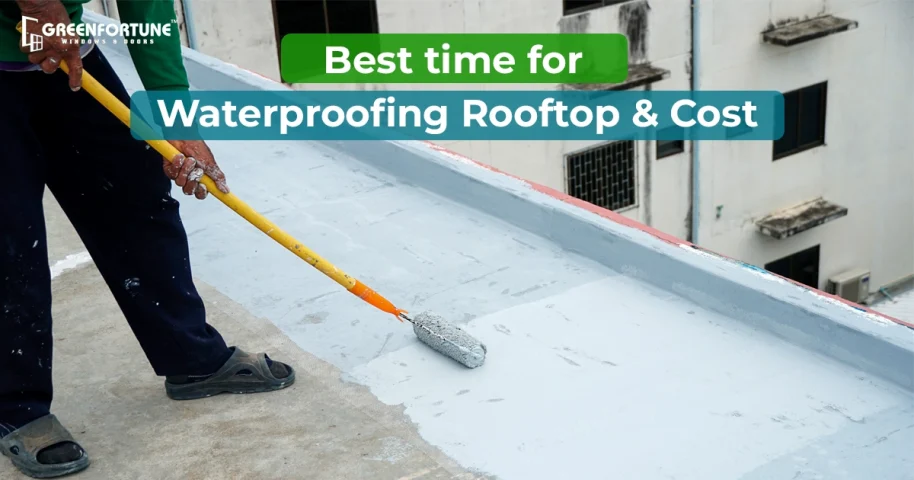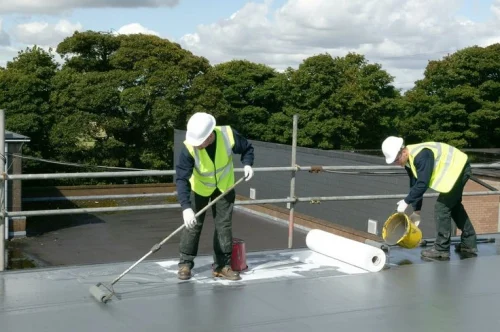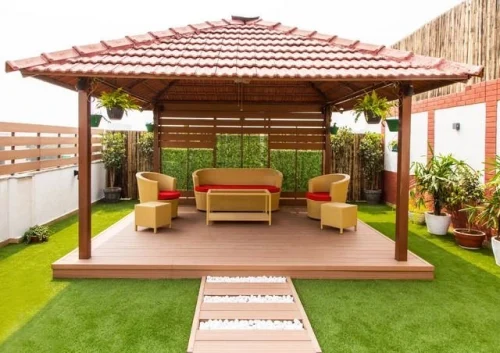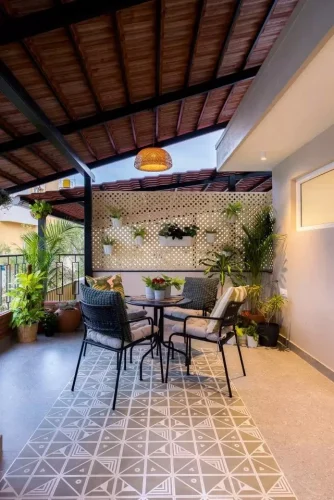
Choosing Between Apartment vs Independent House: A Complete Guide
April 2, 2025
What is Builder Floor? How is it Different from Traditional Apartments?
April 3, 2025The Indian monsoon season is a dramatic clash of sky and earth. Monsoon rains are good because they cool things down after the very hot summer. But, they can also cause big problems for our houses, especially our roofs. If roofs leak, your walls get wet, and houses can get damaged. So, to stop this, we need waterproofing for roofs.
Most people don't know what's the best time to do it. How much does it cost? And how long will it last? So, we are here to help!
Ideal Time for Waterproofing Rooftop
Source: Pinterest
The best time for waterproofing rooftop in India is before the monsoon season arrives. You can do it during the dry months of March to May and here’s why:
- Dry Weather Advantage: Because of the regular dry weather from March to May, waterproofing products for rooftops can cure properly and firmly attach to the roof surface. If the solution will be applied on a damp surface then it might reduce the it's efficiency.
- Preventative Measure: As a proactive measure, waterproofing rooftop before the monsoon can prevent leaks and damage before they even happen. By doing so you can build a barrier to keep the moisture away from the walls.
- Flexibility for Repairs: If your roof needs to be repaired before being waterproofed, doing it during the dry months will allow you enough time to take care of any problems without worrying about rain stopping the job.
Why Not During or After the Monsoon?
Source: Pinterest
During the monsoon, consistent rainfall makes it nearly impossible to apply waterproofing materials effectively. The moisture will hinder proper adhesion and curing.
Post-monsoon, while the weather might be drier, any existing damage caused by leaks will already be done. Also, the roof surface will hold a lot of moisture, which is not ideal for the application of waterproofing rooftop materials.
Also Read: How to Stop a Roof Leaking?
Waterproofing Costs in India
The cost of waterproofing in India depends on several factors:
1. Roof Size: A larger size roof will require more material and labor which will significantly increase the overall cost of waterproofing.
2. Waterproofing Material: Different waterproofing materials have different prices. Some popular options include:
- Bituminous Coatings which are relatively affordable and widely used.
- Polyurethane Coatings offer excellent durability and flexibility but are generally more expensive.
- Acrylic Coatings are cost-effective and easy to apply, but may not be as long-lasting as polyurethane.
- Cementitious Coatings are good for flat roofs and areas prone to waterlogging.
- Membrane Waterproofing is very durable, but requires professional installation and is more costly.
3. Roof Condition: If your roof has existing cracks, leaks, or other damage, repair costs will be on the higher end.
4. Labor Costs: The charges of Labor depend on the region and the expertise of the waterproofing professionals. So, if you employ a professional person the cost will be higher.
5. Accessibility: Difficult-to-access roofs may incur higher labor costs.
Lifespan of Waterproofing Rooftop
Source: Pinterest
The lifespan of your rooftop waterproofing depends on the material used and the quality of application. Generally, you can expect:
Name of the Costing | Life Span (in years) |
Bituminous coatings | 3-5 years |
Acrylic coatings | 3-7 years |
Cementitious coatings | 5-10 years |
Polyurethane coatings | 10-15+ years |
Membrane waterproofing | 15-20 + years |
Also Read: How to Stop Water Leakage from the Wall?
Tips for Ensuring Long-Lasting Waterproofing
- High Quality Materials: Don't compromise on quality to save a few rupees. Opt for reputable brands and materials known for their durability.
- Experienced Professionals: Proper application is crucial for the effectiveness of waterproofing. Choose experienced contractors with a proven track record.
- Regular Maintenance: Inspect your roof regularly for any signs of damage and address them promptly.
- Proper Roof Drainage: Ensure your roof has adequate drainage to prevent water accumulation.
- Surface Preparation: The roof surface must be clean, dry, and free from debris before applying waterproofing materials.
Conclusion
Waterproofing Rooftop is a vital investment for protecting your home from the harsh Indian monsoon. By planning your waterproofing during the dry pre-monsoon months, choosing the right materials, and hiring skilled professionals, you can ensure a leak-free and durable roof for years to come. Remember to factor in the cost, lifespan, and maintenance requirements to make an informed decision. Protect your home, and enjoy the monsoon season without the worry of leaky roofs!
Also Read: Best Waterproof for Cement Techniques
Green Fortune Doors and Windows
Green Fortune Doors and Windows offers a wide range of eco-friendly and sustainable solutions for your home. Our doors and windows are crafted with precision and care, using materials that not only reduce environmental impact but also provide exceptional durability and performance. From stylish doors to sleek glass windows, we try to combine innovative design with a commitment to sustainability, helping you create a greener, more beautiful living space.
Frequently Asked Questions (FAQs)
Q1: How to make a roof waterproof?
A: To make a roof waterproof, apply a waterproof coating or membrane, ensure proper flashing and sealing, and install a waterproof underlayment.
Q2: What is the best waterproofing material for roofs?
A: Popular waterproofing materials for roofs include silicone coatings, polyurethane membranes, EPDM rubber, and PVC sheets.
Q3: How long does a waterproof roof last?
A: The lifespan of a waterproof roof depends on factors like material quality, installation, and maintenance. On average, a well-maintained waterproof roof can last 10-30 years.










